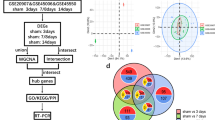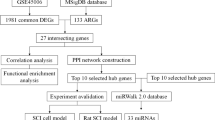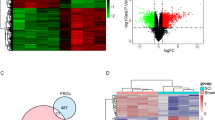Abstract
Immune response is pivotal in the secondary injury of spinal cord injury (SCI). Polarization of macrophages (MΦ) influences the immune response in the secondary injury, which is regulated by several immune-related proteins. M2Φ plays the immunomodulatory role in the central nervous system. This study used bioinformatic analysis and machine algorithms to screen hub immune-related proteins after SCI and experimentally investigate the role of the target protein in the M2Φ polarization and immunomodulation in rats and in vitro after SCI. We downloaded GSE151371 and GSE45006, hub immune-related genes were screened using machine learning algorithms, and the expression of S100A9 was verified by datasets. Allen's weight-drop injury SCI model in Sprague–Dawley rat and bone marrow-derived rat MΦ with myelin debris model were used to study the effects of S100A9 on M2Φ polarization and immunomodulation at the lesion site and in vitro. Bioinformatic analysis showed that S100A9 acts as a hub immune-related gene in the SCI patients and rats. S100A9 increased at the lesion site in SCI rats, and its inhibition reduced CD206 and ARG-1 expression. Exogenous S100A9 promoted CD206 and ARG-1 expression in MΦ. S100A9 also increased the expression of PD-L1 and decreased MHC II at the lesion site in SCI rats and MΦ with myelin debris, and enhanced mitochondrial activity in rat MΦ with myelin debris. In conclusion, S100A9 is an indispensable factor in the immune process in secondary injury following SCI.





Similar content being viewed by others
Data Availability
The datasets and materials supporting the conclusions of this article are included within the article.
Abbreviations
- SCI:
-
Spinal cord injury
- MΦ:
-
Macrophages
- M1Φ:
-
Macrophages
- M2Φ:
-
Macrophages
- PD-L1:
-
Programmed cell death-ligand 1
- MHC:
-
Major histocompatibility
- LASSO:
-
Least absolute shrinkage and selection operator
- RF:
-
Random Forests
- GEO:
-
Gene Expression Omnibus
- CNS:
-
Central nervous system
- PPI:
-
Protein-protein interaction
- ROC:
-
Receiver operating characteristic curve
- ROS:
-
Reactive oxygen species
- DEGs:
-
Differentially expressed genes
- KEGG:
-
Kyoto Encyclopedia of Genes and Genomes
- AUC:
-
Area under the curve
- CD206:
-
Cell surface mannose receptor
- RAGE:
-
Receptor of advanced glycation end products
- TLR4:
-
Toll-like receptor 4
References
Al Mamun A, Monalisa I, Tul Kubra K, Akter A, Akter J, Sarker T, . . . Xiao J (2021) Advances in immunotherapy for the treatment of spinal cord injury. Immunobiology 226(1):152033. https://doi.org/10.1016/j.imbio.2020.152033
Austermann J, Friesenhagen J, Fassl SK, Petersen B, Ortkras T, Burgmann J, . . . Viemann D (2014) Alarmins MRP8 and MRP14 induce stress tolerance in phagocytes under sterile inflammatory conditions. Cell Rep 9(6):2112–2123. https://doi.org/10.1016/j.celrep.2014.11.020
Christofides A, Strauss L, Yeo A, Cao C, Charest A, Boussiotis VA (2022) The complex role of tumor-infiltrating macrophages. Nat Immunol 23(8):1148–1156. https://doi.org/10.1038/s41590-022-01267-2
Deng YJ, Ren EH, Yuan WH, Zhang GZ, Wu ZL, Xie QQ (2020) GRB10 and E2F3 as Diagnostic Markers of Osteoarthritis and Their Correlation with Immune Infiltration. Diagnostics (Basel) 10(3). https://doi.org/10.3390/diagnostics10030171
Dubois C, Marcé D, Faivre V, Lukaszewicz AC, Junot C, Fenaille F, . . . Payen D (2019) High plasma level of S100A8/S100A9 and S100A12 at admission indicates a higher risk of death in septic shock patients. Sci Rep 9(1):15660. https://doi.org/10.1038/s41598-019-52184-8
Fan ZP, Peng ML, Chen YY, Xia YZ, Liu CY, Zhao K, Zhang HP (2021) S100A9 activates the immunosuppressive switch through the pi3k/akt pathway to maintain the immune suppression function of testicular macrophages. Front Immunol 12:743354. https://doi.org/10.3389/fimmu.2021.743354
Feng L, Li M, Ren J, Li Y, Wang Q, Zhang P, . . . Li Y (2021) Proteomic Analysis Reveals that Di Dang Decoction Protects Against Acute Intracerebral Hemorrhage Stroke in Rats by Regulating S100a8, S100a9 Col1a1, and Col1a2. Neuropsychiatr Dis Treat 17:3301–3314. https://doi.org/10.2147/ndt.S331688
Fu Y, Wang J, Zhou B, Pajulas A, Gao H, Ramdas B, . . . Kaplan MH (2022) An IL-9-pulmonary macrophage axis defines the allergic lung inflammatory environment. Sci Immunol 7(68):eabi9768. https://doi.org/10.1126/sciimmunol.abi9768
Gerhards R, Pfeffer LK, Lorenz J, Starost L, Nowack L, Thaler FS, . . . Meinl E (2020) Oligodendrocyte myelin glycoprotein as a novel target for pathogenic autoimmunity in the CNS. Acta Neuropathol Commun 8(1):207. https://doi.org/10.1186/s40478-020-01086-2
Hellenbrand DJ, Quinn CM, Piper ZJ, Morehouse CN, Fixel JA, Hanna AS (2021) Inflammation after spinal cord injury: a review of the critical timeline of signaling cues and cellular infiltration. J Neuroinflammation 18(1):284. https://doi.org/10.1186/s12974-021-02337-2
Herbert DR, Orekov T, Roloson A, Ilies M, Perkins C, O'Brien W, . . . Finkelman FD (2010) Arginase I suppresses IL-12/IL-23p40-driven intestinal inflammation during acute schistosomiasis. J Immunol 184(11):6438–6446. https://doi.org/10.4049/jimmunol.0902009
Hu L, Liu Y, Kong X, Wu R, Peng Q, Zhang Y, . . . Duan L (2021) Fusobacterium nucleatum Facilitates M2 Macrophage Polarization and Colorectal Carcinoma Progression by Activating TLR4/NF-κB/S100A9 Cascade. Front Immunol 12:658681. https://doi.org/10.3389/fimmu.2021.658681
Jaynes JM, Sable R, Ronzetti M, Bautista W, Knotts Z, Abisoye-Ogunniyan A, . . . Rudloff U (2020) Mannose receptor (CD206) activation in tumor-associated macrophages enhances adaptive and innate antitumor immune responses. Sci Transl Med 12(530). https://doi.org/10.1126/scitranslmed.aax6337
Jiang S, Chan CN, Rovira-Clavé X, Chen H, Bai Y, Zhu B, . . . Nolan GP (2022) Combined protein and nucleic acid imaging reveals virus-dependent B cell and macrophage immunosuppression of tissue microenvironments. Immunity 55(6):1118–1134.e1118. https://doi.org/10.1016/j.immuni.2022.03.020
Jukic A, Bakiri L, Wagner EF, Tilg H, Adolph TE (2021) Calprotectin: from biomarker to biological function. Gut 70(10):1978–1988. https://doi.org/10.1136/gutjnl-2021-324855
Kornepati AVR, Vadlamudi RK, Curiel TJ (2022) Programmed death ligand 1 signals in cancer cells. Nat Rev Cancer 22(3):174–189. https://doi.org/10.1038/s41568-021-00431-4
Kwak T, Wang F, Deng H, Condamine T, Kumar V, Perego M, . . . Gabrilovich DI (2020) Distinct Populations of Immune-Suppressive Macrophages Differentiate from Monocytic Myeloid-Derived Suppressor Cells in Cancer. Cell Rep 33(13). https://doi.org/10.1016/j.celrep.2020.108571
Kyritsis N, Torres-Espin A, Schupp PG, Huie JR, Chou A, Duong-Fernandez X, . . . Beattie MS (2021) Diagnostic blood RNA profiles for human acute spinal cord injury. J Exp Med 218(3). https://doi.org/10.1084/jem.20201795
Li H, Xiao Y, Li Q, Yao J, Yuan X, Zhang Y, . . . Yu D (2022) The allergy mediator histamine confers resistance to immunotherapy in cancer patients via activation of the macrophage histamine receptor H1. Cancer Cell 40(1):36–52.e39. https://doi.org/10.1016/j.ccell.2021.11.002
Li J, Shu X, Xu J, Su SM, Chan UI, Mo L, . . . Xu X (2022) S100A9-CXCL12 activation in BRCA1-mutant breast cancer promotes an immunosuppressive microenvironment associated with resistance to immunotherapy. Nat Commun 13(1):1481. https://doi.org/10.1038/s41467-022-29151-5
Li Y, Chen B, Yang X, Zhang C, Jiao Y, Li P, . . . Du J (2019) S100a8/a9 Signaling Causes Mitochondrial Dysfunction and Cardiomyocyte Death in Response to Ischemic/Reperfusion Injury. Circulation 140(9):751–764. https://doi.org/10.1161/circulationaha.118.039262
Mantovani A, Allavena P, Marchesi F, Garlanda C (2022) Macrophages as tools and targets in cancer therapy. Nat Rev Drug Discov 21(11):799–820. https://doi.org/10.1038/s41573-022-00520-5
Marinković G, Grauen Larsen H, Yndigegn T, Szabo IA, Mares RG, de Camp L, . . . Schiopu A (2019) Inhibition of pro-inflammatory myeloid cell responses by short-term S100A9 blockade improves cardiac function after myocardial infarction. Eur Heart J 40(32):2713–2723. https://doi.org/10.1093/eurheartj/ehz461
Mellor LF, Gago-Lopez N, Bakiri L, Schmidt FN, Busse B, Rauber S, . . . Wagner EF (2022) Keratinocyte-derived S100A9 modulates neutrophil infiltration and affects psoriasis-like skin and joint disease. Ann Rheum Dis 81(10):1400–1408. https://doi.org/10.1136/annrheumdis-2022-222229
Monteiro C, Miarka L, Perea-García M, Priego N, García-Gómez P, Álvaro-Espinosa L, . . . Valiente M (2022) Stratification of radiosensitive brain metastases based on an actionable S100A9/RAGE resistance mechanism. Nat Med 28(4):752–765. https://doi.org/10.1038/s41591-022-01749-8
Mosser DM, Hamidzadeh K, Goncalves R (2021) Macrophages and the maintenance of homeostasis. Cell Mol Immunol 18(3):579–587. https://doi.org/10.1038/s41423-020-00541-3
Nalio Ramos R, Missolo-Koussou Y, Gerber-Ferder Y, Bromley CP, Bugatti M, Nunez NG, . . . Helft J (2022) Tissue-resident FOLR2(+) macrophages associate with CD8(+) T cell infiltration in human breast cancer. Cell 185(7):1189–1207 e1125. https://doi.org/10.1016/j.cell.2022.02.021
Ni L, Xiao J, Zhang D, Shao Z, Huang C, Wang S, . . . Zhang X (2022) Immune-responsive gene 1/itaconate activates nuclear factor erythroid 2-related factor 2 in microglia to protect against spinal cord injury in mice. Cell Death Dis 13(2):140. https://doi.org/10.1038/s41419-022-04592-4
Nicolás-Ávila JA, Pena-Couso L, Muñoz-Cánoves P, Hidalgo A (2022) Macrophages, metabolism and heterophagy in the Heart. Circ Res 130(3):418–431. https://doi.org/10.1161/circresaha.121.319812
Pesce JT, Ramalingam TR, Mentink-Kane MM, Wilson MS, El Kasmi KC, Smith AM, . . . Wynn TA (2009) Arginase-1-expressing macrophages suppress Th2 cytokine-driven inflammation and fibrosis. PLoS Pathog 5(4):e1000371. https://doi.org/10.1371/journal.ppat.1000371
Pritchard A, Tousif S, Wang Y, Hough K, Khan S, Strenkowski J, . . . Deshane JS (2020) Lung Tumor Cell-Derived Exosomes Promote M2 Macrophage Polarization. Cells 9(5). https://doi.org/10.3390/cells9051303
Shen H, Xu B, Yang C, Xue W, You Z, Wu X, . . . Dai J (2022) A DAMP-scavenging, IL-10-releasing hydrogel promotes neural regeneration and motor function recovery after spinal cord injury. Biomaterials 280:121279. https://doi.org/10.1016/j.biomaterials.2021.121279
Sun F, Zhang H, Huang T, Shi J, Wei T, Wang Y (2022) S100A9 blockade improves the functional recovery after spinal cord injury via mediating neutrophil infiltration. Exp Ther Med 23(4):291. https://doi.org/10.3892/etm.2022.11220
Sun L, Li M, Ma X, Zhang L, Song J, Lv C, He Y (2019) Inhibiting high mobility group box-1 reduces early spinal cord edema and attenuates astrocyte activation and aquaporin-4 expression after spinal cord injury in rats. J Neurotrauma 36(3):421–435. https://doi.org/10.1089/neu.2018.5642
Toulmin SA, Bhadiadra C, Paris AJ, Lin JH, Katzen J, Basil MC, . . . Eisenlohr LC (2021) Type II alveolar cell MHCII improves respiratory viral disease outcomes while exhibiting limited antigen presentation. Nat Commun 12(1):3993. https://doi.org/10.1038/s41467-021-23619-6
Van Broeckhoven J, Sommer D, Dooley D, Hendrix S, Franssen A (2021) Macrophage phagocytosis after spinal cord injury: when friends become foes. Brain 144(10):2933–2945. https://doi.org/10.1093/brain/awab250
Willenborg S, Sanin DE, Jais A, Ding X, Ulas T, Nüchel J, . . . Eming SA (2021) Mitochondrial metabolism coordinates stage-specific repair processes in macrophages during wound healing. Cell Metab 33(12):2398–2414.e2399. https://doi.org/10.1016/j.cmet.2021.10.004
Wu B, Song M, Dong Q, Xiang G, Li J, Ma X, Wei F (2022) UBR5 promotes tumor immune evasion through enhancing IFN-γ-induced PDL1 transcription in triple negative breast cancer. Theranostics 12(11):5086–5102. https://doi.org/10.7150/thno.74989
Xu P, Zhang F, Chang MM, Zhong C, Sun CH, Zhu HR, . . . Sun GD (2021) Recruitment of γδ T cells to the lesion via the CCL2/CCR2 signaling after spinal cord injury. J Neuroinflammation 18(1):64. https://doi.org/10.1186/s12974-021-02115-0
Zhang M, Liu ZZ, Aoshima K, Cai WL, Sun H, Xu T, . . . Yan Q (2022) CECR2 drives breast cancer metastasis by promoting NF-κB signaling and macrophage-mediated immune suppression. Sci Transl Med 14(630):eabf5473. https://doi.org/10.1126/scitranslmed.abf5473
Zhong C, Niu Y, Liu W, Yuan Y, Li K, Shi Y, . . . Li B (2022) S100A9 Derived from Chemoembolization-Induced Hypoxia Governs Mitochondrial Function in Hepatocellular Carcinoma Progression. Adv Sci (Weinh) 9(30):e2202206. https://doi.org/10.1002/advs.202202206
Zhou X, Wahane S, Friedl MS, Kluge M, Friedel CC, Avrampou K, . . . Zou H (2020) Microglia and macrophages promote corralling, wound compaction and recovery after spinal cord injury via Plexin-B2. Nat Neurosci 23(3):337–350. https://doi.org/10.1038/s41593-020-0597-7
Zhou Y, Shi W, Zhao D, Xiao S, Wang K, Wang J (2022) Identification of Immune-Associated Genes in Diagnosing Aortic Valve Calcification With Metabolic Syndrome by Integrated Bioinformatics Analysis and Machine Learning. Front Immunol 13:937886. https://doi.org/10.3389/fimmu.2022.937886
Zhu X, Liang R, Lan T, Ding D, Huang S, Shao J, . . . Wei B (2022) Tumor-associated macrophage-specific CD155 contributes to M2-phenotype transition, immunosuppression, and tumor progression in colorectal cancer. J Immunother Cancer 10(9). https://doi.org/10.1136/jitc-2021-004219
Acknowledgements
Not applicable.
Funding
This study was supported by a grant from the National Natural Science Foundation of China (No.: 81870976), "136" Hospital Open Fund of Shanxi Bethune Hospital by the Shanxi Provincial Health Commission (No.: 2021YZ04) and Key Projects to Tackle Key Problems (No.: 2020XM27).
Author information
Authors and Affiliations
Contributions
LS conceived and designed the work that led to the submission, played an essential role in interpreting the results, and was a significant contributor to the writing of the manuscript. JQL contributed significantly to the data acquisition, analysis, and manuscript preparation. ZQW performed the experiments and contributed to the data acquisition. BYW performed the experiments and contributed to the data acquisition. CD performed the experiments, helped perform the analysis, and engaged in constructive discussions. WW carried out the literature search, data analysis and manuscript editing. All authors read and approved the final manuscript.
Corresponding author
Ethics declarations
Ethics Approval and Consent to Participate
Not applicable.
Consent for Publication
Not applicable.
Competing Interests
The authors declare that they have no competing interests.
Additional information
Publisher's Note
Springer Nature remains neutral with regard to jurisdictional claims in published maps and institutional affiliations.
Junqiao Lv and Zhiqiang Wang contributed equally to this work and should be considered co-first authors.
Supplementary Information
Below is the link to the electronic supplementary material.
Rights and permissions
Springer Nature or its licensor (e.g. a society or other partner) holds exclusive rights to this article under a publishing agreement with the author(s) or other rightsholder(s); author self-archiving of the accepted manuscript version of this article is solely governed by the terms of such publishing agreement and applicable law.
About this article
Cite this article
Lv, J., Wang, Z., Wang, B. et al. S100A9 Induces Macrophage M2 Polarization and Immunomodulatory Role in the Lesion Site After Spinal Cord Injury in Rats. Mol Neurobiol (2024). https://doi.org/10.1007/s12035-024-03920-3
Received:
Accepted:
Published:
DOI: https://doi.org/10.1007/s12035-024-03920-3




